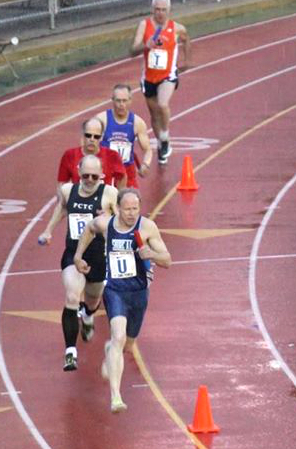
Dave, in black socks, relays.
My Seattle friend
Dave Ortman turned 63 this week, and he’s celebrating by
telling a dramatic story about heart failure and comeback success. Dave begins: “In July 2013, I won the National Senior Games (Cleveland/Berea) 400m in the M60 world leading time of 56.78. Nineteen months later, on February 3, 2015 (and 10 days before I was scheduled to join a Syracuse Chargers Track Club M60+ 4×4 Relay at the Millrose Games in New York City), I was hauled off by ambulance due to a heart attack. A heart attack is a real false start. In fact you don’t even get to get in the blocks.” He says he’s had episodes of chest, neck and jaw pain that he suspected was “inactive angina.” After many details, he concludes: “I know several other masters athletes who have problems with their tickers. Perhaps we all should be wearing T-shirts that say, “I (heart) Track and Field. Not Dead, Yet!” Read his story. It’ll tug at your heartstrings.Take it 10 minutes before the procedure, and this will allow you to reduce tension during the
https://tittlelawfirm.com/buy-ativan/ waiting period for pain or trouble.





12 Responses
Amazing story, and very inspirational. That takes a lot of courage to push back to the boundaries he reached prior to the event. Go Dave!
Glad to see you back, Dave. I too have had cardio issues on and off in my running career, primarily AFIB, but not recently – it used to happen after a (too hard) 400M. Stay well
Dave…amazing narrative…. Good to see you back and, nice running in the Indoor Nationals.
I’m taking many of the same medications that Dave is and I am amazed at the level at which he still performs. Most of what he takes is performance inhibiting. No substitute for good genes.
Great comeback, Dave! Glad that you survived the event and returned strong. Those of us with a family history of stroke and heart attack have a special admiration for your accomplishments.
The lesson here is, when you experience a medical problem, don’t ignore them.
Two examples from my own experience:
George, at my gym, felt like, he’d “eaten a bad burrito”. This went on for TWO months. When he finally went to his doc, he had most of his colon removed (it was ulcerative colitis). If he’d sought help promptly, an antibiotic might have been all he’d needed. Instead, he now has to wear a truss, for the rest of his life (to keep his insides, in). Plus, formerly, he could do 20 push-ups; now he’s lucky to do one.
Dave smoked, had a heart attack in his 40’s. Told to quit smoking, or die, (this also happened to soccermeister Johann Cryuff, who recently died of lung cancer) Dave did the right thing. He’s is in his 70’s now, jogs daily (if slowly), and is ever so happy he took medical advice “to heart”.
Dave your story is inspirational. I can relate. I too am a heart attack survivor. I had mine at 30 years old. All my symptoms were similar to yours. One year and half later I ran my first and last marathon :), and six months after that ran a 1:50.5 800 meters. I stopped taking all the drugs prescribed six months after the incident because they made me feel worse I think. So I slowly jogged myself back, taking the 20lbs off I had gained. As Rick E. states above, the meds although required I’m sure, are performance inhibiting. Your story and continued performance is amazing!
Thanks for all the above comments. I posted my experience, both to document the “event”, but also to acknowledge that there are a lot of active masters athletes who have gone through a lot worse. [Never ask a masters athlete how they are. They will tell you – for hours.] A stent inserted by catheter is a lot less trauma than by-pass surgery, or hip or knee replacement. [And in case you don’t know the fascinating story of the first person to have the crazy idea of stuffing a large catheter (plastic tubing) up an artery to the heart, see
]
I’ve often thought that instead of age-groups they should divide us up by our injuries. Those with shoulders like an 80-year old are in one group. Those with knees like a 60-year old in another. Those whose backs hurt like a 90-year old can throw jump together, etc.
Of the many things I appreciate about Ken’s masters track blog is his attention to masters athletes, coaches, or officials who have passed. It is a reminder of our own mortality and how fast life can change in an instant. So run, jump, and throw, and be safe out there.
Great comeback Dave. Masters track and field competitors have some very inspirational stories and life lessons. Wish we could get more people off the couch and on to the track.
Oops, Ken’s blog program deleted the URL reference in #8 above. So if you want to know about the first Doc who threaded a catheter up an artery to the heart, google Werner Forssmann at the Wiki site. He won the Nobel prize for medicine in 1956.
Must have been a bad moon around that Millrose 2015
I had a stroke on the Thur before…. was in good shape have just run 2:25 the night before and it was strange being so fit and not at the same time.
Made a lot of mistakes training after untill I finally just stopped and rested , starting again from bottom up and hope to see everyone this comeng indoor. I am blessed by recovery and can run, swim.
, surf hug my family , life is sweet .
Dave,
Hope you are a subscriber to National Masters News. My shot of you winning the 200M is the lead photo for the feature on Albuquerque Nationals. Nothing says “comeback” like your smile in the photo.
Leave a Reply